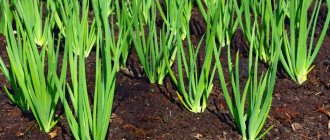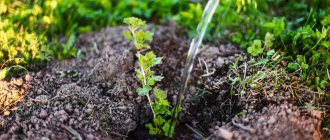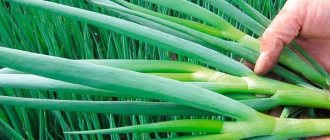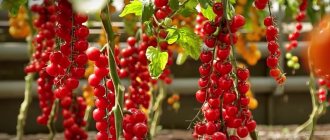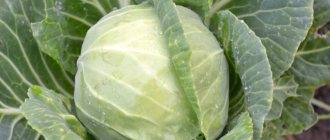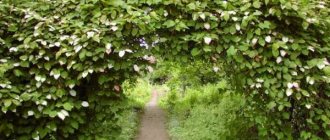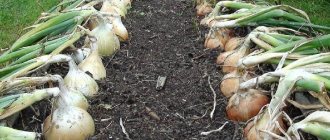Onions are one of the most common crops for growing in garden plots. To get an excellent harvest of this vegetable without hassle, it is better to choose onion sets. There are many varieties, so before you buy any of them, you need to decide what you want to get.
Some inexperienced gardeners do not know what onion sets are. Sets are small onions obtained from small seeds called nigella, usually in the second year.
The best varieties of onion sets: description and features
| Varieties | Description | Peculiarities |
| Sturon | This view is one of the best. Early ripening. The weight of the head is from 80 to 160 g. Its germination and productivity are quite high. Resistant to various types of diseases. Excellent storage. | In terms of taste, it has a pleasant taste with moderate pungency. |
| Stuttgarter Riesen | Gives an early harvest. Bulbs can be of different sizes. From a small mass of 50 g to large ones of 300 g. It gives a high yield and has good shelf life. | The disadvantage of this onion set is the low degree of resistance to downy mildew or rot. |
| Orion | Hybrid of English selection. The variety is early ripening, the rounded bulbs weigh on average about 180 g. | The species is kept quite well. Very popular. |
| Stardust | In terms of maturity – mid-season. Germination is friendly. Vegetable heads store well. | White color of the husk. |
| Centurion | This is a selection of the Stuttgart Riesen variety. The bulbs are slightly oblong. Can be stored for up to 8 months. If the plant is provided with favorable conditions, germination can be 100%. Little susceptible to disease. Shooting is low. | The variety is suitable for producing turnips, but not greens. The taste is quite spicy. |
| shallot | Considered the most elite. The biochemical composition of the variety has a large amount of vitamins and minerals. | It is distinguished by its delicate taste and juicy fibers. Does not cause tears when the bulb structure is destroyed. It has the most harmonious taste qualities. |
| Red Baron | Semi-spicy, aromatic and pleasant. Dark red color. | When grown, it requires careful care - regular watering and weeding of the soil. |
| Exhibition | The bulb of the variety gains its maximum weight in 130 days. Weight up to 800 g. Shelf life – average, no more than 4 months. | The taste of the pulp is sweet. |
| Kaba | Late ripening. The head is round with a slight downward slope. The flesh is white and may sometimes have a slight green tint. The outer husk is light brown or yellow. | The variety is susceptible to diseases, including downy mildew and onion fly attack. |
Onions from seeds in one season - video
To grow onions from seeds in one season, you must first grow seedlings from nigella seeds. The best varieties for this are white onions - Exhibition, Stuttgarter Riesen, Holcedony, Odintsovets, red varieties - Red Baron, Carmen, Carmen MS.
When buying seeds, pay attention to the expiration date. If the year of planting coincides with the final shelf life, it is better not to take such seeds, since their germination rate is no more than 30%. Take seeds that have another 2 years left; their germination rate is 90%.
I have already written about how to grow Exhibition onions on my website, read it. Any onion from seeds can be grown in the same way. Having planted seeds for seedlings in the second half of February, by May the seedlings will grow with 2-3 strong feathers. This will be exactly the time when the seedlings are planted in open ground.
Watch the video on how to grow seedlings from nigella seeds.
Planting onion sets
Onion sets are a plant that does not require intensive care. He is not capricious, he just needs to create suitable conditions:
- when planting, use the recommended pattern: there should be 8-12 cm between two turnips;
- Place adjacent rows at a distance of up to 20 cm;
- deepen by 4 cm;
How to grow onions on a windowsill at home
May is still far away, but now I want to diversify the menu with dishes with green onions. Of course, you can plant the onions in a jar of water. However, to get a larger harvest, how many cans will have to be used... and this will take up a lot of space on the windowsill. Therefore, plant the bulbs in boxes with soil.
Take any box the width of the window sill of your apartment, fill it with nutritious soil. You can use store-bought, or prepare it yourself by taking soil from the garden and adding humus or peat to it.
Prepare the bulbs for planting by first soaking them in warm water with the addition of growth stimulants. Plant the onions at a distance of 3-4 cm. Water the plantings and cover the top with film so that shoots appear faster. Place the box on a warm windowsill, preferably on the sunny side. As soon as green sprouts appear, remove the film. Caring for plantings involves regular watering. But do not overwater, otherwise midges will appear on the seedlings.
Selecting a location
Sowing must be carried out in the correct sequence and following certain actions:
- Disinfect the seeds using a weak solution of potassium permanganate. It is important to change the solution periodically. There are other methods, which we will discuss later in the article.
- It is worth choosing the earliest possible period for planting. A constant temperature of +15 °C is excellent. You can also focus on the thawing of the ground - it should warm up to a depth of at least 5 cm.
It must be taken into account that onion sets in the form of seeds can withstand light frosts when planted, which makes caring for them easier in the early stages. But the bulbs cannot tolerate frost, so they can be placed in the soil only when there is no threat of frost.
- To make the planting more visible, you can mix it with something light, such as sand or chalk.
- Before planting seeds in the soil, it is necessary to water the bed with hot water. The number of seeds per 1 m² is 10 g.
Rule #3 – when to plant?
It is of great importance when to plant onion sets in open ground in the spring - according to rule No. 3, the yield of the crop depends on this. If you hurry too much and plant onions in cold soil, then you can say that the planting material was thrown away. He won't give you any greens or turnips. Everything will go into an arrow, which will be useless to break off, since it will form again and again.
Late planting of onions in the spring is also very bad, since the crop loves soils saturated with melted spring water. When the top layer of soil dries out, germination of the root system will occur with a significant delay, which will invariably affect the yield.
It’s quite easy to independently extend the timing of planting onion sets in the spring. You need to prepare the bed and stick a regular water thermometer into it to a depth of 10 cm. Check. As soon as the temperature remains above 18 ° C at the specified depth for two days in a row, proceed to planting immediately.
This is the optimal time for planting onions in the spring, when groundwater melt is still present, but the soil temperature is already sufficient. Do not forget to cover the subsidence with non-woven material.
The timing of planting onions in the spring, as well as for greens, shifts every year, so it is impossible to give unambiguous advice on this matter. It is advisable to correlate the time of agricultural work on the site with the lunar calendar. It contains information about the most successful days before sowing. In 2022, planting onion sets in the spring in the Moscow region is recommended from May 20 to 23. This period will be optimal.
Look at other suitable dates for planting onions in the spring according to the lunar calendar in the table:
Lunar calendar for planting onion sets in May 2022 | |
| Favorable days for planting a turnip (head) | 1, 20, 21, 22, 23, 31 |
| Favorable days for planting greens (feather) | 1, 8, 9, 10, 17, 18, 26, 27, 28, 31 |
| Unfavorable days for planting | 4, 5, 6, 19 |
Treating onions before planting with salt, potassium permanganate and ash
Most often it is recommended to combine soaking with both growth stimulants and agents that will prevent rotting, attack by parasites or the formation of fungi.
Recipes:
- Potassium permanganate. It is necessary to soak the bulbs in a light pink solution for 2 hours, no more, to prevent damage to the roots. Then rinse them in running water. This method will eliminate the appearance of rot, fungi and mold.
- Salt – 1 tablespoon per liter jar of water. The tubers are immersed in the solution for two hours. You don't have to rinse it. Such soaking gives positive results against putrefactive processes and the formation of mold spores.
- Copper sulfate - 1 teaspoon per ten-liter container of water. The bulbs are soaked in the composition for 5-8 minutes. Disinfection occurs and the risk of disease is reduced.
- Ash also eliminates the risk of mold growth and reduces susceptibility to disease. It is combined with salt and a solution of potassium permanganate. The proportion is in a light pink solution of potassium permanganate with a volume of 3 liters. add 2 tbsp. l. ash from wood and salt. The heads are soaked for 2 hours.
Treating onions before planting against pests with birch tar
Birch tar is a remedy that can suppress onion fly damage to vegetables. It is enough to make a solution of 1 tbsp. l. birch tar per liter container of water. Keep the bulbs in it for no more than 15 minutes. In addition, this liquid is good for watering at the root.
Pests and diseases
To organize proper care, it is important to know what causes onions and what insects can harm them. Dangerous diseases for onions include neck, gray and white rot, as well as jaundice, fusarium, downy mildew (downy mildew), smut, rust, mosaic and tracheomycosis.
White rot develops in acidic soils, so try to lime the acidic soil in the area. In addition, excess nitrogen in the soil contributes to the development of the disease. Diseased specimens must be removed from the garden bed, and before storing the bulbs for storage, they are dusted with chalk for preventive purposes.
Gray mold is caused by a fungus, and damp and rainy weather contributes to the spread of the disease. Diseased bulbs need to be removed, and as a preventive measure, strict adherence to agrotechnical conditions and spring treatment of onions with a solution of copper sulfate give good results.
Onion jaundice is a viral disease that deforms flowers and forms chlorotic spots on leaves. It is impossible to cure a viral disease, so it is necessary to immediately remove from the site not only specimens with its symptoms, but also keep the onion beds and row spaces clean, removing weeds as soon as they appear. And, of course, observe crop rotation.
Downy mildew (downy mildew) appears on leaves and stems as light, oblong spots with a gray coating, which gradually turn black. Bulbs affected by downy mildew begin to germinate early during storage; diseased plants do not produce seeds. To destroy the causative agents of peronosporosis, the collected bulbs are heated for 10 hours at a temperature of 40 ºC before storing. To avoid disease, make sure that onion plantings are not too thick.
Fusarium is manifested by yellowing of the tips of the feathers, as rot and tissue death develop in the area of the bottom of the bulb. This is a fungal disease that is especially active during hot seasons. The cause of fusarium can be damage to the plant by the onion fly. As a preventive measure, warming up the seed before planting is used.
Symptoms of smut look like convex translucent dark gray stripes, on which the tissues crack over time, releasing fungal spores, and the tips of the leaves dry out. To protect bulbs placed for storage from disease, they need to be heated before storing at a temperature of 45 ºC for 18 hours. As a preventative measure, remove weeds in a timely manner and do not sow different varieties of onions in the same area.
Rust appears as brown-red swellings on onion leaves containing fungal spores. As a preventive measure, you can use warming the collected bulbs at a temperature of 40 ºC for 10 hours before storing them. Monitor the density of the beds and promptly remove specimens with symptoms of the disease from them.
Tracheomycosis is a consequence of fusarium: rot begins from the lower tissues of the bulb, gradually rising higher and spreading to the entire bulb, causing death of the roots and yellowing of the onion feathers. Remove plants with symptoms of tracheomycosis, follow the rules of agricultural technology and crop rotation.
Neck rot of onions is manifested by a dense gray coating of mold on the outer scales, which over time turns into black spots. The disease appears after harvesting the bulbs, and subsequent symptoms appear about two months later. Late varieties are especially susceptible to infection. The disease develops when onions are grown in unfavorable conditions, so the main rule should be compliance with agrotechnical conditions, as well as warming up the sets before planting and the collected bulbs before storing them at a temperature of 45 ºC.
Mosaic turns onion leaves into flat, corrugated patches with yellow stripes, onion inflorescences become smaller, there are fewer seeds, and the plant lags behind in growth. This is a viral disease, and it can only be dealt with prophylactically.
All fungal diseases can be easily treated with fungicides, but before you treat onions, think about the fact that bulbs tend to accumulate not only nutrients, but also poisons, so we do not recommend that you use chemicals to combat diseases.
- How to sow snapdragon seedlings, how to care for seedlings
Of the insect pests, the most dangerous insect pests for the plant are onion moths, moths and flies, sprout flies, mole crickets, cabbage cutworms, garden and winter cutworms, and tobacco thrips.
- Treatment of plants with a one percent solution of Bitoxibacillin or a half percent solution of Gomelin is effective against cutworm caterpillars.
- Treatment with Actellik or Karbofos (0.15%) helps against tobacco thrips.
- The secretive proboscis is destroyed with systemic insecticides.
- Germ fly larvae die during deep autumn digging of the site.
- The onion fly is afraid of the smell of carrots - alternate rows of onions with rows of carrots, and the onion fly will fly around your area.
- In the fight against onion moths, it is necessary to promptly remove weeds from the site during the season, and at the end of the season - all plant residues, follow the rules of agricultural technology and crop rotation.
- The common mole cricket is lured with traps: they dig holes half a meter deep in several places in the area, put horse manure in them and cover them with shields made of boards. When mole crickets climb into them to bask, they are destroyed.
Timing for planting onion sets in open ground
Young onions need warm soil. The optimal time is at soil temperature +12…+15 °C. It is important that the ground is not frozen at a depth of several centimeters.
Despite the fact that frosts can damage the bulb, you should not delay planting too much. After all, newly planted, it will not tolerate dry, hot weather well. Yes, and awakened insects can significantly damage the young bulb.
In temperate climates, they focus on the flowering period of bird cherry. In warmer regions, planting can begin as early as March.
Important - the return of frost can destroy the bulb.
If you don’t want to wait a long time, you can simply make a higher ridge. This method has proven itself well in the northern regions.
By raising the ground level a few centimeters from the base layer, you can increase the soil temperature by +5...+8 °C.
Cleaning and storage
The plants themselves will tell you when the fruit is ready. Young feathers stop appearing, the leaves begin to fade and turn yellow, the upper scales of the bulb acquire the characteristic color of the milking variety. If such signs appear, do not delay, start cleaning. Have time to complete the harvest before the first frost and the first morning dew.
Freshly dug onions need to be dried for a week, otherwise they will rot. What to do if onions rot during storage, this material is written. If weather permits, scatter the onions directly in the garden bed. After drying, trim the remaining feathers, leaving a “tail” of 3-4 centimeters. To disinfect and ensure long-term storage of the crop, warm the onions to a temperature of 40 degrees for about an hour.
The dried onions are placed in prepared containers. The container must be made of breathable materials. Wooden boxes, fabric bags or nets for vegetables, and nylon stockings work well. It is best to store the packaged harvest in a cool, dry place - a cellar or basement. You can read more about storing onion crops here.
Technology for planting onion sets
If a seedling onion is planted to produce a turnip, a distance of 10 cm should be left between the bulbs. The row spacing is 20 cm.
To obtain greenery, you can use a denser planting option. In this case, the bulbs are adjacent to each other. And you can plant them not as deep as in the first case.
If you need both turnips and greens, use a checkerboard planting option. Rows are performed more often. And the bulbs are planted in two adjacent furrows, offset in relation to each other and a little denser than in the case when only turnips are needed.
Steps:
- Make grooves about 5 cm deep.
- Treat the bed with a solution of Fitosporin with a concentration of 1 teaspoon per 10 liters. or simply add fine salt to the soil in the garden bed. You can sprinkle wood ash for disinfection.
- Then plant onion sets. Deepen it so that about 1/3 of the bulb protrudes above the surface of the ground.
- After this, cover with soil about 2 cm above the bulb.
Soil selection and preparation
Onions grow well only on light soils, but not entirely on sand: light loams or sandy loams are optimal. He also has an excellent attitude towards planting on black soil. Even the close occurrence of groundwater is not a hindrance, as long as it is not wetlands. The soil for onions should be moderately moist and in no case acidic. In case of high acidity, preliminary liming with chalk, slaked lime, dolomite flour, etc. is necessary.
For onions, areas that are well illuminated by the sun should be allocated: even the shadow of fruit trees or a fence will negatively affect the harvest. Onions respond very well to increased doses of fertilizers, but it should not be fresh manure: in this case, a beautiful feather will grow, but the bulb, although large, will not be able to be stored for a long time. But over the course of a year, for previous crops, the application of manure is justified.
Onion beds should be located away from trees so that they are constantly illuminated by the sun
The beds for planting onions are prepared in the fall, while there is time. For digging and removing weeds, add at least one and a half buckets of humus or good compost, a half-liter jar of wood ash and up to 80 g of azofoska per 1 m2. In the case of clay soils, add up to a bucket of river sand at the same time. In the spring, before superficial loosening of the soil, it is advisable to add another handful of halls per square meter. After this, the bed is leveled and compacted a little.
Caring for onion sets in open ground
Caring for the seedlings is very simple:
- Weeding will help make the soil looser, which is exactly what this vegetable likes. In this case, the earth will not turn into a crust and will not form a solid lump.
- Get rid of any weeds in a timely manner.
- If the onion greens begin to turn yellow or white, apply nitrogen-containing fertilizers, but only in May, after which their use will provoke the growth of the greens to the detriment of the turnips.
- 2 weeks after the first feeding, you can add a potassium-containing mixture to enhance the effect.
- If you don’t want to use chemicals, vermicompost, ash or an infusion of nettle or other types of herbs will do.
Instead of nitrogenous fertilizers, you can use ammonia. To do this, just take two tablespoons of ammonia and dilute them in a container with ten liters of water. To properly apply such fertilizing, you must first moisten the bed with clean water and only then walk along the row with a solution of ammonia.
Harvesting
Onions fall to the ground in mid-July-August. If the feathers turn yellow and dry, this is a sign of maturation. The vegetable is pulled out with shoots. The harvested crop is dried under a canopy for two weeks. When the feather is completely dry, it is removed, leaving only a small tail up to 3 cm long.
Grown onion sets
Mr. Summer Resident advises: what to do to prevent the bow from going into the arrow
To prevent the bow from throwing out the arrow in advance, use one of these options:
- Wintering in a heated room - this option can only be controlled if the bulbs are stored at your home.
- In the case of purchased bulbs, it is also possible to prevent premature discarding of the arrow. We need to arrange a period of adaptation. Keep them next to a heating device for 14-15 days, and then place them in a heated room.
- A warm bath with water at +40 °C may help. You need to keep the bulbs in it for 8 hours. But the most important thing is that the water is warm all the time. Afterwards, you need to thoroughly dry the bulbs and store them in a place at room temperature.
Growing onions is not a troublesome task. You will be able to reap a good harvest if you follow the recommendations presented in the article.
Reviews
Grigory, 49 years old, Cherepovets
We grow the first green onions in our greenhouse. We can’t do without these vitamins even in winter; onions with green feathers grow in a rectangular tray without soil, on water alone. I want to say that we always cut off both the dry roots at the bottom of the onion and the dry tops. In my opinion, the feather grows faster this way.
Mikhail, 38 years old, Taganrog
We men cannot live without green onions, so we have to grow them. I never apply any fertilizers to onions - neither chemicals nor organics. But you can’t grow onions that easily. Therefore, instead of fertilizers, in the spring I add chopped winter rye into the soil where the onion beds will be.
Raisa Fedorovna, Ufa
To prevent mole crickets and onion flies, I pour furrows under the onions with a solution of a glass of salt and 2 tbsp. kerosene in a bucket of water. Sometimes I use birch tar instead of kerosene. Pests also don’t like it very much, or rather, they don’t like its smell. I pour dry ash into the furrows and soak the bulbs in a salt solution. The onion grows with a thick green feather and a good large turnip.
Tamara, 64 years old, Pavlodar
Proper care of onions must begin with proper soil preparation; you cannot add fresh mullein or droppings to the ground, otherwise there will be no escape from the grass. Then you will have to weed the beds very often, because the onions in the grass will be small and tasteless.
Onion greens and onion heads are a very necessary product on our tables. I would like it to be on the menu of every housewife not only in summer, but also in winter. But if you fail to grow green onion feathers in severe cold, then there will always be a place for onion heads in the cellar, attic or refrigerator.
Health to you and your loved ones! Natalya Belokopytova.
Growing and care
While the onion is growing, it needs careful care - watering, hilling, weeding, protection from diseases and insects.
Watering
Onions like a moderate amount of moisture. 2 waterings per week are enough. In dry times, daily watering is allowed.
Loosening and weed control
Loosening should be carried out as the soil compacts to provide the crop with sufficient oxygen. Weeds are also removed as they grow.
Top dressing
Fertilizers can be applied before and after planting. If there has been no preparatory work, you should adhere to the following scheme:
- 20–30 days after sowing, add a solution of bird droppings or mullein.
- During the period of bulb formation, use potassium monophosphate.
Disease and pest control
On open ground, onions are susceptible to a number of diseases. For example:
- bacterial rot;
- fusarium;
- gray rot.
To reduce the risk of diseases, treatment is carried out with folk or industrial means. To repel pests, you can plant calendula and marigolds next to the beds.
How to choose planting material
When choosing a variety, focus on taste, ripening time and shelf life. Yellow onions store better than red or white onions, but the latter are milder in taste. Many gardeners love yellow Stuttgarter, which is also a winter plant. Sweet and semi-sharp onions are often added to salads. Yalta and Exhibition are popular among them.
When buying seedlings for planting, pay attention to its integrity. The onions should be dry and firm, without spots or other formations. The optimal size in diameter is 10-22 mm.
Which onion to plant on the head in spring
To avoid problems, special attention is paid to the selection of seed material. A quality onion set should be:
- dry;
- dense to the touch;
- evenly colored (dark or white spots are a sign of disease).
The sets are sorted by size: larger specimens (from 22 to 30 mm in diameter) are left for feather production, and small ones (15-21 mm) are ideal for growing onions per head.
Reference. Very small sets (less than 15 mm) are suitable for winter planting. If you sow such onions in the spring, the harvest will be late, which is not acceptable for all regions.
Varieties and hybrids
The varietal characteristics of the seed material are also of great importance. Onion heads must form before the onset of autumn frosts, so for planting in spring it is better to choose early and mid-season varieties and hybrids:
- Centurion F1, Sturon, Red Baron, Golden Semko F1 - early ripening, resistant to bolting and fungal diseases, characterized by high yield and good keeping quality;
- Hercules F1, Carmen MS, Stardust - medium early, resistant to diseases and bolting;
- mid-season - Shetana, Stuttgarter Riesen, Danilovsky, Odintsovets, Red Semko F1.
How to prepare a site for planting
To grow onions, choose a well-lit area without nearby groundwater. Neutral acidity of the soil and light fertile soil - chernozem - are preferred. However, with proper application of fertilizers, sandy loam, loam or peat bogs are also suitable.
Onions are best grown in raised beds. This ensures suitable water and temperature conditions. The soil warms up more efficiently, and sedimentary water does not linger in the soil. Layers of compost and organic mulch further nourish the soil.
When organizing a garden bed, adhere to the rules of crop rotation:
- The optimal predecessors are nightshades (tomatoes, potatoes, eggplant), melons (cucumbers, zucchini, squash, pumpkin), as well as cabbage, spinach and lettuce.
- It is not recommended to plant onions where umbrellas (dill, cumin, parsley, parsnips), root vegetables of the cabbage family (turnips, radishes, radishes) and legumes (beans, peas) were previously grown.
- After growing onions, the soil should rest from the crop for at least 3 years.
It is advisable to prepare the site in advance - in the fall or 1.5-2 months before planting. The earth is dug up, weeded from weeds and fertilizers are applied:
- compost (5 kg/m²);
- in the case of acidic soils - wood ash or dolomite flour (200 ml/m²);
- minerals - ammonium nitrate, superphosphate, potassium sulfate or “Nitroammofoska” in accordance with the instructions (20-30 g/m²).
Fertilizers are applied to a depth of 30-40 cm; for better absorption of nutrients, the soil is watered and then leveled with a rake.

